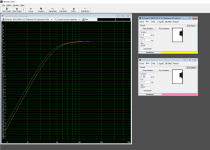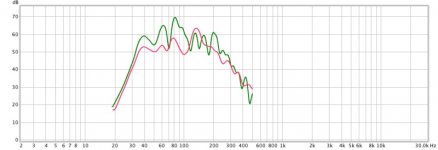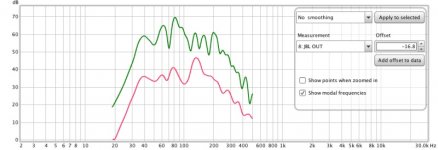Hi everyone, I have been posting on this forum quite a bit so hope I'm not taking up too much room. Thanks for all the responses, they really help.
I am a bit confused about what 'EQ-ing' a subwoofer means. I understand it has something to do with flattening the response but how is it done? Is it a physical process? Could it help me get lower bass in a sealed enclosure?
I'm on the fence between two drivers, one 12'' which is more efficient and better at power handling and one 10'' which is less efficient but has a marginally better bass response. Could I EQ the 12'' to have a more desirable bass response? Someone mentioned a Linkwitz Transform and that it could help in this scenario at a cost to efficiency. Whats the go with that? I had a little look into it and it sounds pretty technical.
Here is a screenshot of the Transfer function magnitude graphs of each driver in a 1.3 ft^3 box which seems to be a fairly good size for both drivers (correct me if I am wrong).
YELLOW = 12''
PINK = 10''
Thanks!
I am a bit confused about what 'EQ-ing' a subwoofer means. I understand it has something to do with flattening the response but how is it done? Is it a physical process? Could it help me get lower bass in a sealed enclosure?
I'm on the fence between two drivers, one 12'' which is more efficient and better at power handling and one 10'' which is less efficient but has a marginally better bass response. Could I EQ the 12'' to have a more desirable bass response? Someone mentioned a Linkwitz Transform and that it could help in this scenario at a cost to efficiency. Whats the go with that? I had a little look into it and it sounds pretty technical.
Here is a screenshot of the Transfer function magnitude graphs of each driver in a 1.3 ft^3 box which seems to be a fairly good size for both drivers (correct me if I am wrong).

YELLOW = 12''
PINK = 10''
Thanks!
Hi, at lo frequencies it makes sense to equalize stuff on the small-signal side, before the power amp. But with any of the drivers thou chose, equalization does not seem that necessary to me, because their simulated responses are fine.
Due to room gain, contra- and subcontrabass frequencies are amplified, the more or less closed pressure chamber which the room is amplifies the rumbling. Therefore linear loudspeaker response down to 16 Hz is not needed and not even wanted, as a driver would blow up trying to play 16 Hz with full amplifier power.
To decide which driver to use, have a look at and preferably hands on magnet drives, mechanical parameters and construction. The larger linear and altogether possible excursions and the more graceful the stopping at both ends the better.
Due to room gain, contra- and subcontrabass frequencies are amplified, the more or less closed pressure chamber which the room is amplifies the rumbling. Therefore linear loudspeaker response down to 16 Hz is not needed and not even wanted, as a driver would blow up trying to play 16 Hz with full amplifier power.
To decide which driver to use, have a look at and preferably hands on magnet drives, mechanical parameters and construction. The larger linear and altogether possible excursions and the more graceful the stopping at both ends the better.
Some links:
Hi Myleso,
Your 10" driver (RSS265HF-4) would be fine in anything between .5 and 1.5ft^3, and the 12" driver (RSS315HF-4) would like between 1 and 3ft^3. Change you simulation to show the output w/ the driver(s) @ Xmax to compare the high output capabilities. What you have to evaluate is the output capability in your chosen enclosure, and if it fits your requirements. I doubt that the 10" has higher bass output than the 12".
In general term EQ stands for equalization, or modifying the electrical input to a loudspeaker to suit the operator. This can be done between preamplifier and power amplifier, with active as well as passive electronic circuits, or, inside the loudspeaker usually w/ passive components unless the loudspeaker has a build-in amplifier... This could be done for controlling room effects, or for altering the response of the loudspeaker, or just because... As it has been mentioned in your other threads before, if you are looking for an explanation of the Linkwitz transform, then this describes it much better than I could:
ESP - The Linkwitz Transform Circuit
Linkwitz Transform Subwoofer Equaliser
and, I think the original Linkwitz site has also been mentioned before, there you can find reasonably simple working explanations from buffer circuits to filters to L/T transforms, and additional links:
Active Filters
Regards,
Hi Myleso,
Your 10" driver (RSS265HF-4) would be fine in anything between .5 and 1.5ft^3, and the 12" driver (RSS315HF-4) would like between 1 and 3ft^3. Change you simulation to show the output w/ the driver(s) @ Xmax to compare the high output capabilities. What you have to evaluate is the output capability in your chosen enclosure, and if it fits your requirements. I doubt that the 10" has higher bass output than the 12".
In general term EQ stands for equalization, or modifying the electrical input to a loudspeaker to suit the operator. This can be done between preamplifier and power amplifier, with active as well as passive electronic circuits, or, inside the loudspeaker usually w/ passive components unless the loudspeaker has a build-in amplifier... This could be done for controlling room effects, or for altering the response of the loudspeaker, or just because... As it has been mentioned in your other threads before, if you are looking for an explanation of the Linkwitz transform, then this describes it much better than I could:
ESP - The Linkwitz Transform Circuit
Linkwitz Transform Subwoofer Equaliser
and, I think the original Linkwitz site has also been mentioned before, there you can find reasonably simple working explanations from buffer circuits to filters to L/T transforms, and additional links:
Active Filters
Regards,
Some thoughts on EQing sealed subs...
- Assuming thermal limits aren't an issue, the maximum SPL of a given driver in a sealed cabinet (of ANY size) is set by the cone area, maximum excursion, and frequency of interest.
- Smaller boxes make it harder for the cone to move, so you have to put more power in to get the same excursion (output) as a bigger box. You do not gain max.SPL by using a bigger box. You do gain efficiency.
- Very small boxes add distortion in two ways. First, the air inside the box is non-linear and you start making relatively large changes in air pressure. Secondly, because efficiency will be low, the motor will be passing more current, which means more distortion. Infinite baffle subs (where it's a sealed box, but big enough to completely let the driver do it's own thing without any acoustic loading) are the logical extension of sealed boxes, and have very low distortion.
- Sealed boxes are terrible for thermal power handling. The driver's motor is in a small confined space and can't vent anywhere. If you're planning on hammering this sub, consider mounting the magnet outwards or adding heatsinking to the cabinet.
I'd consider a measurement setup pretty much mandatory for any home setup. Rooms do hideous things to the low-frequency response of any subwoofer. The room here has a +10dB spike at 40Hz. Enough to mess anything up.
Chris
- Assuming thermal limits aren't an issue, the maximum SPL of a given driver in a sealed cabinet (of ANY size) is set by the cone area, maximum excursion, and frequency of interest.
- Smaller boxes make it harder for the cone to move, so you have to put more power in to get the same excursion (output) as a bigger box. You do not gain max.SPL by using a bigger box. You do gain efficiency.
- Very small boxes add distortion in two ways. First, the air inside the box is non-linear and you start making relatively large changes in air pressure. Secondly, because efficiency will be low, the motor will be passing more current, which means more distortion. Infinite baffle subs (where it's a sealed box, but big enough to completely let the driver do it's own thing without any acoustic loading) are the logical extension of sealed boxes, and have very low distortion.
- Sealed boxes are terrible for thermal power handling. The driver's motor is in a small confined space and can't vent anywhere. If you're planning on hammering this sub, consider mounting the magnet outwards or adding heatsinking to the cabinet.
I'd consider a measurement setup pretty much mandatory for any home setup. Rooms do hideous things to the low-frequency response of any subwoofer. The room here has a +10dB spike at 40Hz. Enough to mess anything up.
Chris
To decide which driver to use, have a look at and preferably hands on magnet drives, mechanical parameters and construction. The larger linear and altogether possible excursions and the more graceful the stopping at both ends the better.
The two drivers are different sizes in the same series, the Dayton Audio Reference HF series. I am asuming the build quality and materials are the same but the 12'' drive has a 2mm larger Xmax and is more efficient. I am thinking of going with this driver for those reasons. Thanks for your response 🙂
Your 10" driver (RSS265HF-4) would be fine in anything between .5 and 1.5ft^3, and the 12" driver (RSS315HF-4) would like between 1 and 3ft^3. Change you simulation to show the output w/ the driver(s) @ Xmax to compare the high output capabilities. What you have to evaluate is the output capability in your chosen enclosure, and if it fits your requirements. I doubt that the 10" has higher bass output than the 12".
In general term EQ stands for equalization, or modifying the electrical input to a loudspeaker to suit the operator. This can be done between preamplifier and power amplifier, with active as well as passive electronic circuits, or, inside the loudspeaker usually w/ passive components unless the loudspeaker has a build-in amplifier... This could be done for controlling room effects, or for altering the response of the loudspeaker, or just because... As it has been mentioned in your other threads before, if you are looking for an explanation of the Linkwitz transform, then this describes it much better than I could:
ESP - The Linkwitz Transform Circuit
Linkwitz Transform Subwoofer Equaliser
The 12'' defiantly has a higher bass output at any given input due to better efficiency, but it would have to be playing louder in the 60hz range to get the same spl in the lower frequencies. Still, I think the 12'' is a better option.
I think the Linkwitz transform is a little out of my league at the moment. Do you think Equalising the sub is necessary? Cheers 🙂
I'd consider a measurement setup pretty much mandatory for any home setup. Rooms do hideous things to the low-frequency response of any subwoofer. The room here has a +10dB spike at 40Hz. Enough to mess anything up.
What do you mean by a measurement set up?
I'm not going to be pounding this sub all day every day, I probably won't even get a amp that can drive this to RMS. The ability to play quite loud would be nice though. Thanks for you help 🙂
Measurement setup = mic + preamp + laptop. Some way of making graphs out of frequency sweeps.
Chris
Chris
Hi Myleso,
Post #5: "...the Linkwitz transform is a little out of my league at the moment. Do you think Equalising the sub is necessary?"
Yes, I think that's why chris661 is suggesting a measurement setup, so you can analyze what you actually have.
Read through the Elliott Sound articles on Eq and Lt anyway, they are really good.
If you can: go w/ the 12", and the largest box you can tolerate within your room/limits. Then boost the low end, and see what you get... 🙂
Regards,
Post #5: "...the Linkwitz transform is a little out of my league at the moment. Do you think Equalising the sub is necessary?"
Yes, I think that's why chris661 is suggesting a measurement setup, so you can analyze what you actually have.
Read through the Elliott Sound articles on Eq and Lt anyway, they are really good.
If you can: go w/ the 12", and the largest box you can tolerate within your room/limits. Then boost the low end, and see what you get... 🙂
Regards,
Basic "EQ" involves moving the sub around the room. Big differences from place to place (and best polarity and integration with the mid speaker changes too). Might well make a whole lot more difference at the lowest notes than anything you can do with electric EQ.
Good chance an LT curve isn't all too different from a tone control, if you have one.
B.
Good chance an LT curve isn't all too different from a tone control, if you have one.
B.
To illustrate my point, here is the same sub moved maybe 3 feet, same input. The first chart shows how they would sound at my ears, 1/12 smoothing. In the second, I've moved the traces apart to see them separately better.
Neither is a great curve, but second one seems nicer to my eyeballs because the low bass, while lower absolutely, is relatively closer to the trend for the upper bass. Well, good enough for $40 at the thrift store.*
BTW, in testing three rather different subs (smaller ported, bigger ported, bigger with passive radiator), the differences between any were quite small when in the same location. The conclusion is that the room has more to say about bass than anybody's sim supposes.
Ben
*JBL PowerBass PB12.... maybe us$500 originally
Neither is a great curve, but second one seems nicer to my eyeballs because the low bass, while lower absolutely, is relatively closer to the trend for the upper bass. Well, good enough for $40 at the thrift store.*
BTW, in testing three rather different subs (smaller ported, bigger ported, bigger with passive radiator), the differences between any were quite small when in the same location. The conclusion is that the room has more to say about bass than anybody's sim supposes.
Ben
*JBL PowerBass PB12.... maybe us$500 originally
Attachments
Last edited:
Myleso. On Linkwitz's site you will see he advocates dipole bass to reduce room interaction amongst other things. Definitely worth considering. Would almost certainly still need some EQ
- Status
- Not open for further replies.
- Home
- Loudspeakers
- Subwoofers
- What does 'EQ-ing' a subwoofer entail?

